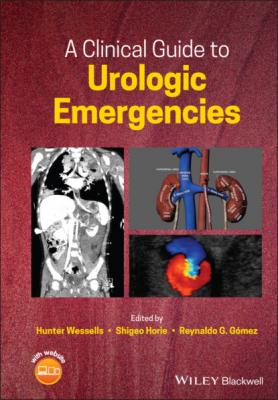A Clinical Guide to Urologic Emergencies. Группа авторов
Читать онлайн.| Название | A Clinical Guide to Urologic Emergencies |
|---|---|
| Автор произведения | Группа авторов |
| Жанр | Медицина |
| Серия | |
| Издательство | Медицина |
| Год выпуска | 0 |
| isbn | 9781119021490 |
Blank cells indicate missing data.
a Series with N < 100 not included.
b Data showing grade and management of blunt renal injuries only.
Pathophysiology
Blunt trauma injury to the kidney is thought to occur as a result of kinetic energy transmission, often as a consequence of rapid deceleration forces or direct interaction of structures in the environment with the soft tissues and bones of the flank and then the kidney. Studies using animal models have shown that the kidney has viscoelastic properties and that damage occurs as a result of stresses that cause tissue deformations exceeding an impact energy threshold of 4 J [20, 21]. A three‐dimensional animal model also demonstrated that the primary site of load‐bearing, where injuries result from, is the junction between the renal pelvis and the renal cortex [21]. Research has also demonstrated that the kidney with a fluid‐filled structure (i.e. ureteropelvic junction obstruction, hydronephrosis, or renal cyst) may be more prone to rupture due to the hydrostatic pressure and resulting distribution of forces within the kidney [20, 22].
Children may have a higher risk of significant renal injury from blunt trauma and this is thought to be related to the proportionately larger kidney for their body size as compared to that of adults, the possibility of children retaining fetal lobulations that may predispose to parenchymal disruption, and the pediatric kidney having less protection due to lower perirenal fat content, weaker abdominal muscles, and less ossification of the rib cage [23, 24].
The proportion of patients with renal trauma found to have congenital anomalies varies, depending on different series, ranging from 1 to 23% [23]. One series that reviewed 193 pediatric renal trauma patients found that just over 8% of patients had a congenital anomaly [25]. Data regarding renal trauma and congenital anomalies is somewhat mixed, with most studies suggesting that congenital anomalies increase the risk of significant renal injury and decrease the possibility of renal salvage, while other series suggest that there is no effect on morbidity or mortality [25-30]. Overall consensus is that pre‐existing renal anomalies likely increase the vulnerability of kidneys in blunt renal trauma [4, 30]. They may also complicate the management of a renal laceration involving the collecting system or parenchyma (e.g. horseshoe kidney with complex arterial vasculature, UPJ (ureteropelvic junction) obstruction, etc.).
Diagnosis
Workup
A complete history, including the crash mechanics and velocity of impact as well as known pre‐existing renal disease or abnormality, should be obtained if possible. For example, renal injury frontal and side impact collisions may be impacted by direct contact from seatbelt and steering column [31]. Seatbelt use and airbag deployment are also important characteristics to note; absence of a seatbelt is associated with higher probability of thoracoabdominal injury [32]. Compared to individuals who did not have airbag deployment with vehicle collision, those with frontal and side airbags have a 46 and 53% decrease in renal injury, respectively [33]. Vehicle characteristics are important given the association of increased crash test rating (i.e. safer car) with lower likelihood of thoracoabdominal injury [32].
Blunt trauma caused by a blow to the flank, rib fracture, or rapid deceleration injury should make clinicians
